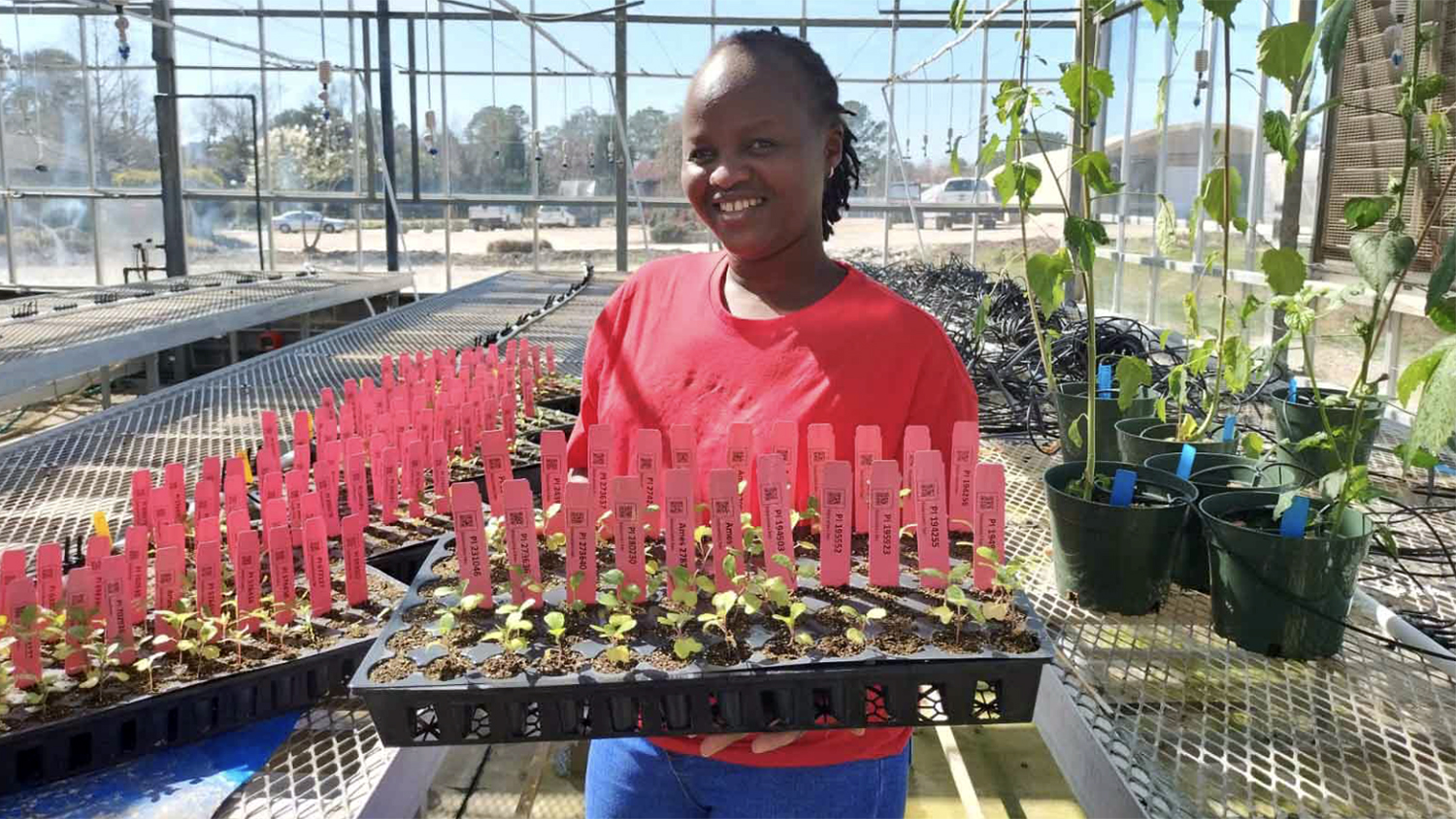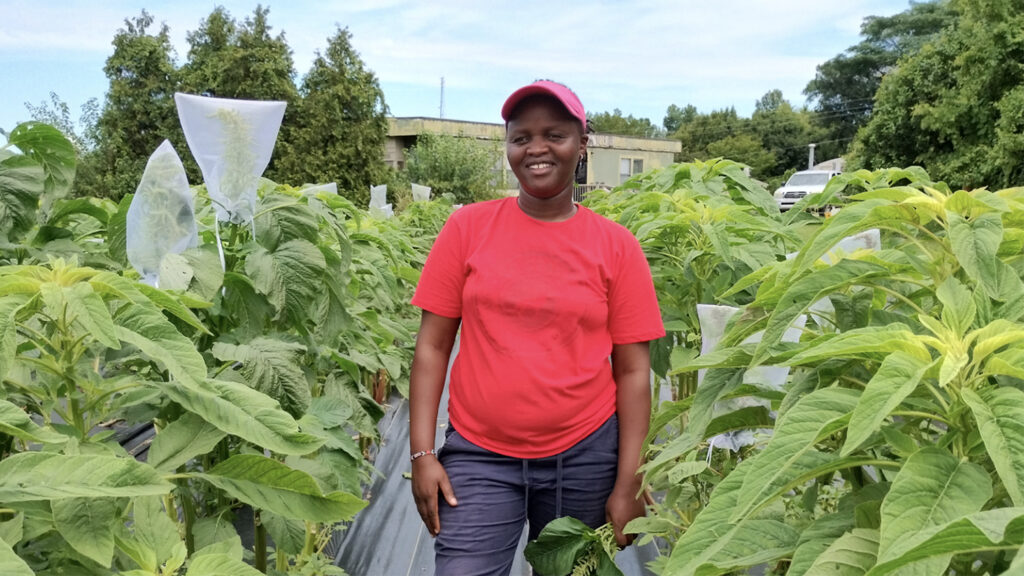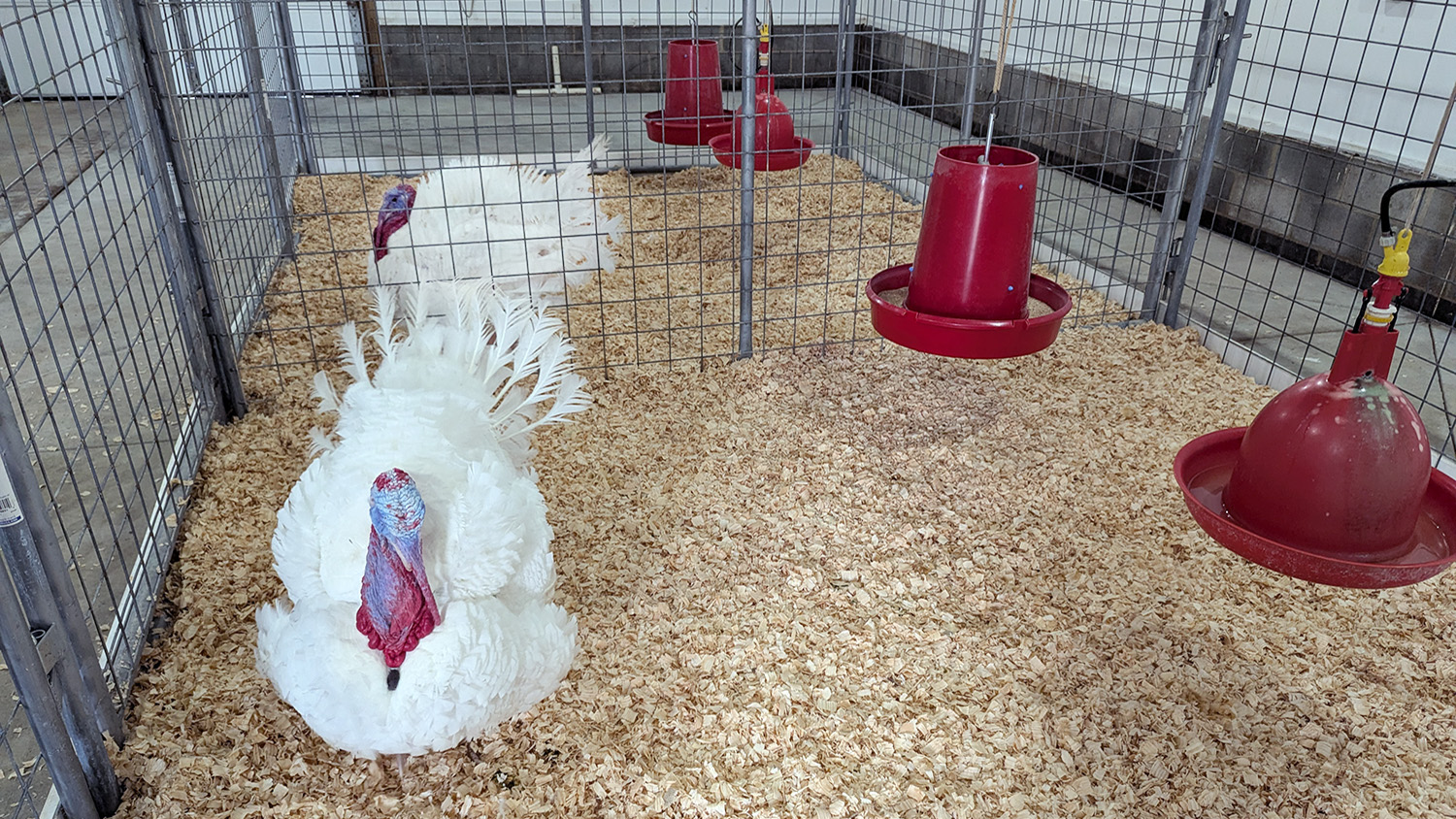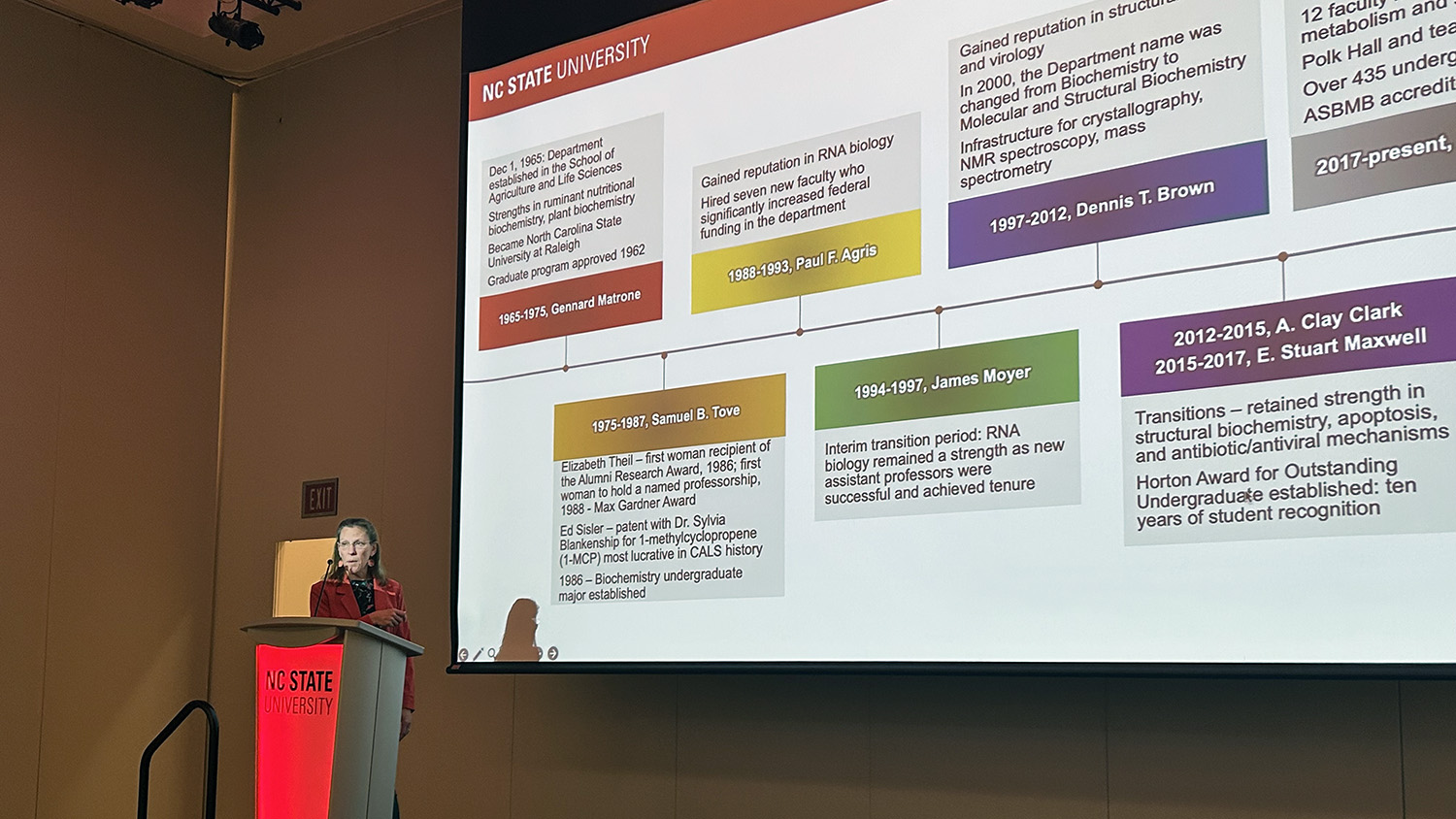Cultivating African Indigenous Vegetables

Growing up in Kenya, Gladys Wanja Njeri was surrounded by agriculture. Her family’s livelihood depended on farming in their village in Nyeri County, where coffee was the main cash crop alongside maize, bananas and potatoes.
Njeri’s parents are professional growers. They use a mixed-crop farming system for all food crops and till the land with simple tools. Her immediate and extended family spend most holidays weeding, pruning or picking coffee on farms to help pay for school fees. Through that work, Njeri’s parents were able to support her undergraduate studies at the University of Eldoret in Kenya, where she majored in horticulture science management.
Now, as a graduate student in the Department of Horticultural Science in the College of Agriculture and Life Sciences at NC State University, Njeri is working with Carlos Iglesias, director of NC State’s Plant Breeding Consortium, to breed African Indigenous Vegetables for nutritional value and climate adaptation with the goal of improving food security for her village back home. Her research is part of a joint project with KALRO (Kenya Agricultural & Livestock Research Organization) and the University of Nairobi and financed by USAID (U.S. Agency for International Development) through the Horticulture Innovation Lab.
We caught up with Njeri to learn more about her research, her passion for agriculture and her hopes for the future.
How did you become interested in horticulture?
Despite my family always having food throughout the year, other families in my village who did not have big portions of land could not afford meals during drought seasons. This encouraged me to want to learn about ways of increasing food availability in our farms through irrigation. The urge to learn about African food systems motivated me to select horticulture as a course even though my parents wanted me to study teaching as a profession. I had already learned an important slogan early enough, ”You can never go wrong with food,” because people must always eat to stay alive. Agriculture is the backbone of Kenya’s economy and all of us depend on it for income and food. However, during droughts, we harvested very little or no food and one time we received food donations from the government, which was never enough. I always thought that there must be a way to get out of this but did not know how until I read about plant breeding of drought tolerant crops and my interest developed from there.
Which African Indigenous Vegetables does your research focus on? What are some of your research goals?
Some of the African Indigenous Vegetables (AIVs) in my research project include African nightshade (Solanum spp), Amaranthus (Amaranthus spp), spider plant (Cleome gynandra), slender leaf (Crotaralia spp), jute mallow (Corchus olitorius), cowpeas (Vigna uinguiculata) and Ethiopian kale (Brassica carinata). These vegetables are traditionally wild and are collected from the forests, bushes, roadside or dumpsites where they grow naturally, although most of them are now domesticated by farmers and grown as a source of food and income.
AIVs generally mean traditional vegetables which are perceived to have been used by local communities many years ago and are still in use in some countries. But they have been neglected by researchers, leading to their genetic erosion. The goal of my research project is to characterize and generate baseline comparative information about genetic diversity, nutritional composition and overall adaptation of the AIVs among communities to solve problems of nutrition deficiencies and improve their economic lifestyles.
Approximately 20% of Kenyans, mostly children, are undernourished and rank among the top in micronutrient deficiencies globally. By implementing my research findings, there will be improved nutrition and dietary diversification by consumption of AIVs in rural and urban households. My goal is to contribute my knowledge to research for foods that bring sustainable nutrition to families while fighting food insecurity and solving malnutrition health conditions. My research includes:
- Introduction of seeds from available accessions in the USDA ARS GRIN germplasm collection (total of 200 entries)
- Germination and seedling establishment under greenhouse conditions
- Transplant to the field and test for adaptability to the local environmental conditions
- Tissue sampling for DNA extraction
- Molecular profiling of single nucleotide polymorphisms (SNPs)
- Sampling the final intended product for each species (leaves, fruits, etc.) and nutritional characterization
- Molecular and nutritional characterization for comparative analysis
- Selection of better adapted and most nutritional genotypes for further seed increases, future research and crop promotion
How has the joint venture between KALRO, University of Nairobi, USAID and the Horticulture Innovation Lab impacted your research?
The joint venture between KALRO, University of Nairobi, USAID and the Horticulture Innovation Lab has impacted my research by providing a guideline for connecting research, education and outreach to farmers which will act as a blueprint in my research. The main goal will be to enhance AIV production, to supply climate smart improved food security, better nutrition and stable incomes among smallholder farmers. My research is supported by the USAID grant through the Horticultural Innovation Lab which is supporting my studies at North Carolina State University. The findings will be useful in farmer training through extension services. The organizations have developed a framework for ensuring farmers not just produce, but also find the market for fresh vegetables and value-added AIVs as well as provide healthy diets to their families.
How will your research impact nutrition, income generation and employment in parts of Africa?
My research findings will create awareness about the potential of AIVs to solve malnutrition while providing food security among vulnerable communities. AIVs are known to contain dense micronutrients like beta-carotene, calcium, zinc and iron. For instance, African nightshades (Solanum spp) are known to contain high Iron while amaranth is known to contain high calcium; a 100 gms intake of cowpeas leaves provides a protein content of 4.2g and calcium of 110 mgs. The World Health Organization recommends a daily intake of 400 gms of vegetables and fruits every day per person, which is normally not the case in many African households due to the costs of buying the vegetables or lack of accessibility. AIVs are easy to grow, mature quickly (within three to four weeks) and do not need complicated recipes to prepare, which makes them an easier vegetable crop for low-income families to farm.
AIVs have become popular in developing urban towns due to immigration from rural villages and many farmers are now involved in growing them for business. The main beneficiaries of the AIVs market are women and youths, where women grow them while youths transport them to the market. AIVs have become a major income earner for villages in Africa where these vegetables are highly produced and consumed. By promoting these vegetables, governments will solve problems of unemployment among youths because agriculture is the biggest employer in many African countries.
How will your research be used in the future?
It will generate genetic and nutritional information that can be used for the selection, promotion and distribution of diverse, productive and highly nutritional AIV species/varieties, providing a low-cost solution to malnutrition in rural East Africa. My goal is to generate information and improve alternatives to cope with issues of malnutrition, income generation and environmental instability. The findings will lead to the selection of better adapted and most nutritional genotypes for further seed increases, future research and crop promotion. My research project will also contribute to the advancement of the existing knowledge about AIVs which U.S. citizens can adopt as part of their meals and school feeding programs.

Are there any challenges or lessons learned from your research while at NC State?
Some of the challenges during my research include a lack of awareness by some people about AIVs because they are regarded as poisonous (Solanum spp) or weeds (Amaranth spp). Describing to the locals about amaranth as a delicacy while they consider it a herbicide-resistant weed is a challenge. Also, some of the seeds we got from commercial vendors did not germinate or had poor germination thus delaying the start of my project at the beginning of the summer.
How does this experience play into your larger academic and career goals?
I had been doing farmer training in Kenya before I commenced my master’s program. Many times I was involved in planning crop schedules over several seasons and guiding farmers by offering agronomic support. However, many farmers grow the popular exotic vegetables like collards, cabbage and capsicum which sometimes fill the market and fetch very low prices due to competition. Through the knowledge I am getting from my studies and my research project, I am equipping myself to train rural women and youths through extension services about the alternative, highly nutritious African Indigenous Vegetables, their significance in diets and their use as a source of income either in groups or at individual levels. I intend to start a demo farm showcasing these valuable vegetables and inviting farmers to come and learn about them. My bigger plan is to develop and produce seeds of AIVs and sell them to farmers across East Africa because access to quality seeds is also a challenge. The gospel of AIVs and their nutritional benefits needs to be preached to everyone for a food-secure future.
- Categories:


